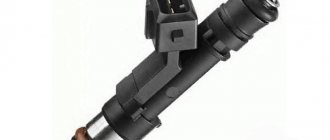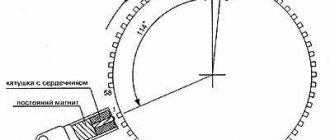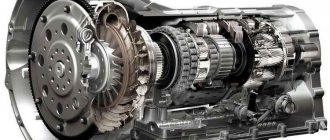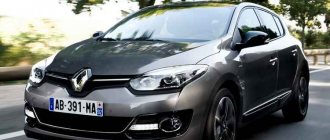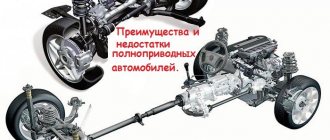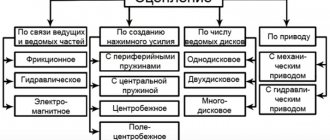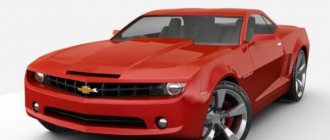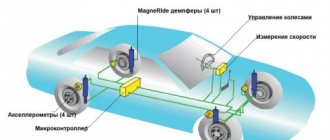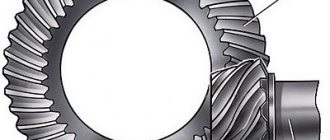The high beam control system is designed to improve visibility at night by automatically turning on the high beam headlights. At the same time, the system allows you to drive with headlights on high beam for the maximum possible time, prevents dazzling other road users, makes driving easier, and thereby increases traffic safety.
The high beam control system is implemented depending on the type of headlights:
- halogen headlights
- due to automatic switching on (off) of the high beam headlights (for example, the
Light Assist
); - xenon headlights
- due to automatic rotation of the lamp module in the vertical and horizontal planes, while the high beam headlights do not turn off (for example, the
Dynamic Light Assist
).
The automatic high beam system includes a light switch, a video camera, a control unit, a high beam lamp (lamp module), and an indicator lamp on the instrument panel.
The high beam control system is activated by the light switch when it is moved to a certain position.
The system uses a black and white video camera that records the situation in front of the car. The coverage area of the video camera is about 1000 m. The video camera together with the control unit are located in the rear view mirror housing.
Along with information from the video camera, the system uses input signals from wheel speed sensors ( to estimate the vehicle speed
), light sensor (
to assess the light level
).
The control unit processes the video camera image and sensor signals, based on which the situation on the road is assessed:
- visibility conditions:
- movement trajectory;
- light level;
- power of oncoming light flow.
Depending on the specific situation, the high beam headlights are turned on and off (turning the lamp module).
The indicator lamp on the instrument panel indicates that the system is turned on and the nature of its operation.
How the system works
The high beam system automatically turns on the high beam headlights when the following conditions are met simultaneously:
- low light level;
- operation of low beam headlights;
- vehicle movement at a certain speed;
- absence of ahead or oncoming vehicles (cars, motorcycles);
- movement outside populated areas.
In order to prevent dazzling other road users, the high beam headlights are automatically switched off in the presence of oncoming or ahead vehicles. Switching occurs when the vehicle is within the system's coverage area and at a certain distance from the vehicle (the high beam beam should not reach the vehicle). When passing (overtaking) a vehicle, the high beams automatically turn on.
When driving through a populated area, the system is triggered depending on an assessment of the light level. If the ambient light is judged to be sufficient, the headlights automatically switch to low beam. Otherwise, the vehicle moves through a populated area with headlights on high beam.
Light Assist is an automatic high beam control system (high beam assistant). This assistance system increases safety and helps the driver when driving at night. The essence of its work is to automatically switch the high beam to the low beam. We will tell you more about the device and operating features in the article.
How Light Assist works
The operating conditions of the complex will depend on the type of headlights installed. If the headlights are halogen, then automatic switching occurs between low and high beam depending on the situation on the road. With xenon headlights, the reflective element in the headlight automatically rotates in different planes, changing the direction of the light. This system is called Dynamic Light Assistant.
The main components of the device are:
- Control block;
- interior lighting mode switch;
- black and white video camera;
- headlight module (reflective element);
- light sensors;
- dynamic control sensors (wheel speed).
To activate the system, you must first turn on the low beam, then switch the switch to automatic mode.
The black and white video camera and control unit are located in the rearview mirror. The camera analyzes the road situation in front of the car at a distance of up to 1,000 meters. It recognizes light sources and then transmits graphic information to the control unit. This means that the source (an oncoming vehicle) is recognized before it is blinded. The length of the high beam light beam usually does not exceed 300-400 meters. The high beam automatically turns off when an oncoming vehicle enters this area.
The control unit also receives information from light sensors and wheel speed sensors. Thus, the control unit receives the following information:
- level of illumination on the road;
- speed and trajectory of movement;
- the presence of oncoming light flow and its power.
Depending on the traffic situation, the high beams are automatically turned on or off. The operation of the system is indicated by the indicator lamp on.
BDC: Body Domain Controller
The Body Domain Controller (BDC) is the central control unit in the on-board network.
At the same time, the BDC control unit is a gateway converter for the remaining control units. The central gateway (ZGM) is integrated into the BDC control unit as an independent control unit. The Body Domain Controller (BDC) is the master control unit for the exterior lighting functions. The BDC control unit determines which lighting functions are to be activated or deactivated. Many functions require information from sensors, contacts, and switches. The BDC control unit receives component signals (eg from ride height sensors) and provides the corresponding information to the bus subscribers.
The BDC control unit is connected via the K-CAN3 bus to the front left headlight electronic control unit (FLEL) and to the front right headlight electronic control unit (FLER).
Prerequisites for activation
Automatic high beam switching will operate under the following conditions:
- low beam headlights are on;
- low light level;
- the car moves at a certain speed (from 50-60 km/h), this speed is perceived as moving on the highway;
- there are no oncoming cars or other obstacles ahead;
- the car moves outside populated areas.
If oncoming cars are detected, the high beam will automatically go out or the angle of the reflective headlight module will change.
Volkswagen was the first to introduce such technology (Dynamic Light Assist). The use of a video camera and various sensors has opened up new possibilities.
The leading competitors in this area are Valeo, Hella, All Automotive Lighting.
Such technologies are called Adaptive Front lighting System (AFS). Valeo introduces the BeamAtic system. The principle of all devices is similar, but may differ in additional functions, which may include:
- driving around the city (works at speeds up to 55-60 km/h);
- country road (speed 55-100 km/h, characterized by asymmetrical lighting);
- driving on the highway (over 100 km/h);
- high beam (Light assist, automatic switching);
- illumination of turns while moving (depending on the configuration, the module rotates at an angle of up to 15° when turning the steering wheel);
- turning on the lighting in bad weather conditions.
How the lighting system is controlled
The driver controls all lighting devices from inside the vehicle using special switches.
Switching on the low and high beams, fog lights and dimensions in most car models is carried out using the steering column switch or a key on the instrument panel:
- first position of the switch – all devices are turned off;
- second position – the dimensions are turned on;
- third position – low beam headlights come on.
Also, a switch located on the left side under the steering wheel allows you to change the low and high beam in the headlights.
If there are fog lights, an additional section can be installed on the switch that regulates turning the PTF on and off. Control can also be done using a separate key.
The combination switch is also used to activate the right and left turn signals. But at the same time, the alarm system is activated using a separate button located on the dashboard.
Many elements of the lighting system light up automatically when certain actions are performed by the driver:
- brake lights - when you press the brake pedal;
- Reversing light - when reverse gear is engaged;
- trunk and glove compartment lighting devices - when they are opened;
- illumination of the driver's feet and dimensions in the doors - when the door is opened.
Advantages and disadvantages of Light Assist systems
Such technologies have received recognition from drivers. Reviews show that the system works smoothly and without failures. Even when overtaking the car in front on an unlit highway, the high beam headlights do not blind the rear view mirrors. At the same time, the high beam remains working. An example is Dynamic Light Assist from Volkswagen. It was not possible to identify any particular disadvantages.
Technologies like Light Assist do their job perfectly. Thanks to them, driving modern cars becomes safer and more comfortable.
Instructions for installing and configuring FLA (high beam assistant) on the MQB car platform using the example of the Volkswagen Passat B8
Good day, VAGdrivers!
Front Light Assist
serves to automatically turn on or off the vehicle's high beams. In order for the high beam to turn on automatically, you need to switch the lighting to Auto mode and turn on the high beam by moving the lever away from you. While the car is stationary, only the low beam will work, but if in the dark you accelerate to a speed above 60 km/h, then in the absence of oncoming traffic, the FLA system will automatically turn on the high beam. A camera on the rearview mirror monitors traffic flow. With its help, the system recognizes oncoming vehicles and vehicles moving ahead in the same direction and automatically switches back to low beam.
In order to install the FLA system on a VAG car built on the MQB platform, you need to purchase:
1) Frameless auto-dimming rearview mirror with integrated camera 3G0 857 511 AE
2) Mirror bracket trims
3) Wiring harness for connecting to the CAN bus
Additionally you will need:
- Screwdriver Set
- Wedge for dismantling plastic parts
- Torx T20 screwdriver
- Cloth tape
- Plastic ties
With the tools and parts available, installation can begin.
1) The first thing you need to do is remove the original rear view mirror:
- To do this, you should arm yourself with plastic pullers and use them to unfasten both decorative trims of the rear view mirror support;
- After the covers are removed, you can remove the mirror itself. It is removed by turning it counterclockwise relative to the point of its attachment to the windshield;
- When you have the mirror in your hands, you can disconnect the power connector from it and put aside the original mirror (we won’t need it anymore).
2) Now you can do the wiring. You need to sequentially repin the connector for the mirror and run a new wire from the mirror to the gateway:
- The wiring connector that connects to the mirror needs to be re-pinned. Namely, you need to remove the white wire from the connector and rearrange it in accordance with the photographs below, and also add two CAN bus wires to the connector;
- Now you need to stretch the CAN bus wires to the connection point. To make it easier, we will solder to the CAN bus in the area where the wiring connectors are attached, which is located to the left of the left leg rest. In order to run the wire, we will have to remove the left windshield pillar trim and secure the new wire in place with the other wires that run there.
- In order to get to the wiring connectors, you need to remove the left threshold cover and pull out the black connector from the mount (as shown in the photo);
- Two orange CAN bus wires go to this connector, which must be cleaned and connected to the wires that we extended from the new mirror with the FLA function;
3) Now that the wiring is separated and connected, you can carefully put everything back together and secure the wires with plastic zip ties, and install the new mirror in its rightful place. It is installed in the same way as the old one was removed, only it is latched clockwise.
Great! Now that the mechanical part of the installation is complete, you can connect YOUR diagnostic tool and perform the final coding of the FLA function. To do this, open the diagnostic tool and go to select the control unit:
1) Go to block 19
(Data bus diagnostic interface) CAN-Gateway => equipment list =>
block 20
(High beam assistant) => check the box => save (coding accepted) 2) Go to
block 20
(High beam assistant) => long coding => there are zeros, but we need to write everything from the beginning:
- 0 bytes
(low beam) — set 04 for LED headlights (for other headlights, select the corresponding different code); - 1 byte
(high beam) - set 04 for LED headlights (for other headlights select the corresponding different code); - 2 bytes
(steering wheel location) - leave 00, since it is for left-hand drive; - 3 bytes
(determining the height of the camera position) - set EC for Passat B8 (for example, on the Skoda Octavia a7, it will be E5); - Then we leave zeros and get this encoding: 04 04 00 EC 00 00 00 00 00 00 00
(14 zeros).
3) We go back to block 9,
but now we go to the “closed area” (password 31347) and go to the “Adaptation” section and put there:
- _Erweiterte_Fernlichtsteuerung - _Basis, FLA
- _Menuesteuerung Fernlichtassistent - _available
- _Menuesteuerung Fernlichtassistent Werkseinstellung — _available
The main thing you need to remember is that the coding of the mirror itself is done purely for the vehicle’s equipment!
That is, another car may have a different part of the encoding (due to different headlights, for example). Now that the coding is finished, we need to go to the menu on the head unit => settings => lighting => high beam assistant => check the box. And we check the functionality of the function: switch the lighting to Auto mode and press the high beam switch once “from yourself” - the high beam icon with the letter A should light up on the dashboard.
Congratulations! You have successfully installed the FLA system on your car! =) We wish you good luck in your plans and remember that nothing is impossible!
You can get acquainted with other systems/assistants of the Volkswagen concern in a separate
Another auxiliary system, designed to make the driver’s work easier and increase driving safety, is called Light Assistant. This system automatically controls the switching between the vehicle's low and high beams. Its main task is to give the driver the opportunity to drive for as long as possible in the best lighting conditions.
Depending on which headlights are used on the car, the principle of operation of the system changes. If the headlights are halogen, the high beams automatically turn on and off depending on road conditions. In xenon headlights, the high beam does not turn off, and dazzling oncoming drivers is prevented by the fact that the lamp module automatically rotates vertically or horizontally.
What is a car lighting and light signaling system?
A modern car includes a whole complex of lighting devices, which together make up the lighting system. Its main tasks include:
- lighting of the roadway and roadside;
- additional road lighting in fog, rain, snowfall;
- informing other drivers about the maneuvers being performed;
- braking warning;
- informing about the dimensions of the machine;
- warning about a breakdown that causes the vehicle to interfere with the roadway;
- ensuring the readability of the registration plate in the evening and at night;
- lighting of the interior, engine compartment and trunk.
Front optics include low and high beam headlights, daytime running lights, side markers and turn signals
KAFAS Camera and FLA Camera
Whether the FLA camera or KAFAS camera is equipped depends on the vehicle's equipment.
The coverage area of the video sensor in the camera is approximately 1000 m.
To recognize oncoming or ahead traffic participants, the area in front of the vehicle is monitored at a distance of up to 1000 m. This makes it possible to recognize oncoming vehicles already at a distance of approx. 1000 m, cars in front are at a distance of approx. from 600 m.
Read more: Car engine water hammer: signs, consequences, repairs
The light points, light colors and light intensity recorded by the camera are analyzed in the KAFAS control unit or FLA control unit.
System overview
The following figure shows a simplified view of the complex glare-free high beam headlight control system using the G11 as an example.
| Designation | Explanation | Designation | Explanation |
| 1 | Left LED headlight | 2 | Stepper motor for adaptive headlights |
| 3 | Outside high beam | 4 | Laser radiation |
| 5 | Internal high beam | 6 | Electronic front left headlight control unit (FLEL) |
| 7 | KAFAS chamber heating | 8 | KAFAS control unit with stereo camera |
| 9 | Right LED headlight | 10 | Internal high beam |
| 11 | Laser radiation | 12 | Outside high beam |
| 13 | Stepper motor for adaptive headlights | 14 | front right headlight electronic control unit (FLER) |
| 15 | Body Domain Controller (BDC) | 16 | CAN bus terminator |
| 17 | Light control panel | 18 | Instrument cluster (KOMBI) |
| 19 | Steering column switch center | 20 | rain/light/sun sensor |
| 21 | High beam assist (FLA), not in combination with KAFAS (i.e. the FLA function is integrated in the KAFAS control unit) | 22 | FLA camera, not in combination with KAFAS camera |
